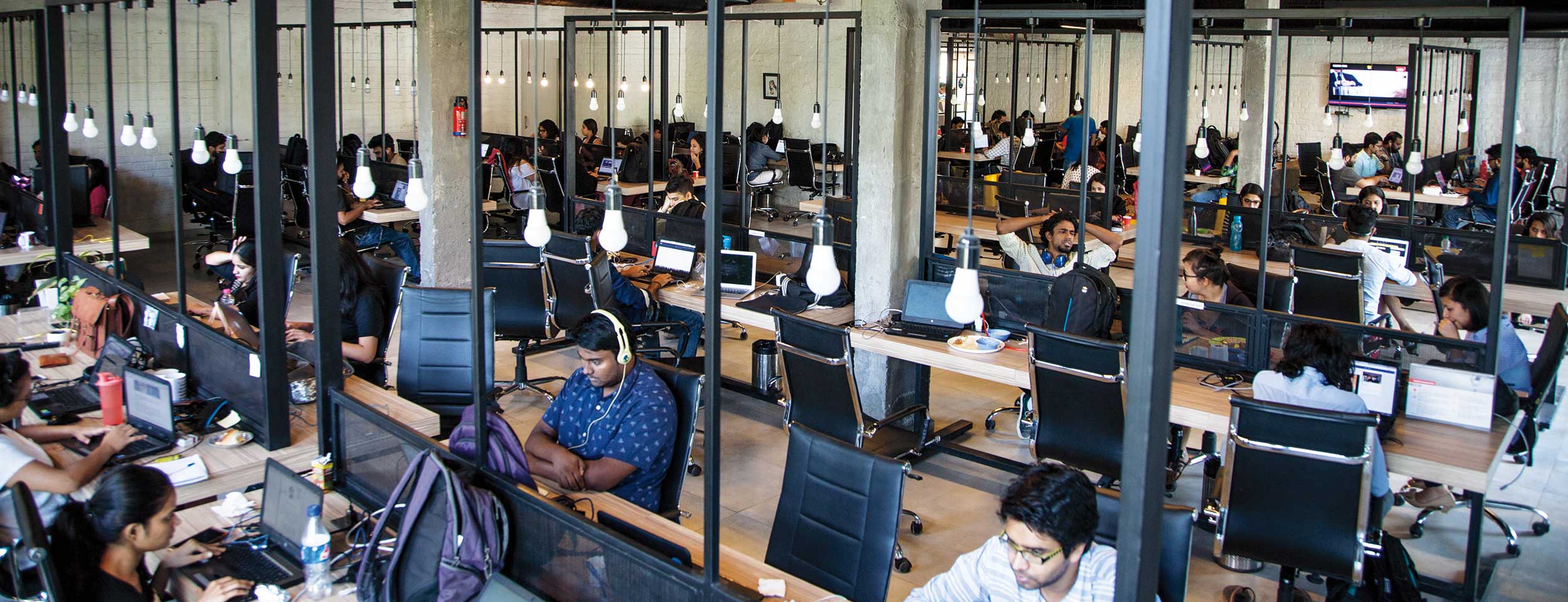In January 2011, I found myself huddled in the basement of a refurbished textile factory in Mumbai unexpectedly pondering the future of digital news in India. I had just been hired as employee number three of a yet-to-be-named news and opinion website to be launched by Network 18, a sprawling Indian media conglomerate best known for operating Indian outposts of big US brands like CNN, CNBC, and MTV.
Sitting in the windowless conference room that January morning, I anticipated no more than novelty: to be part of an innovative, if modest, experiment in a still-developing media universe dominated by legacy giants.
I was wrong.
Over the next four years, our website, unimaginatively but aptly named Firstpost, would ride a tidal wave of political turmoil in India, serendipitously aligned with a period of dizzying digital expansion. The newsroom was made up of a motley crew of renegade legacy media veterans, US returnees, and recent college graduates impatient with the decorum of Indian newspaper op-eds and the access-driven customs of TV journalism. As executive editor, I oversaw a staff committed to representing a riotous diversity of unvarnished opinion that reflected a new urban India no longer beholden to power or the powerful.
We annoyed everyone: liberals appalled by the unabashed right-wing cheerleaders; nationalist trolls whose displeasure was writ large on our comment boards; intellectuals who declared our headlines too brash; and the many readers who often deemed our English too highfalutin. Yet we grew and grew and grew, from 2.5 million unique visitors in its first year to 10 million in 2013 and 20 million in 2015. Our upward trajectory was driven in part by the propulsive expansion of internet users in India, a community that jumped from 125 million in 2011 to 277 million in 2015, when India surpassed the US in the number of people online, becoming second only to China. In 2014, Facebook India crossed the 100 million user mark, up from 41 million just three years earlier.
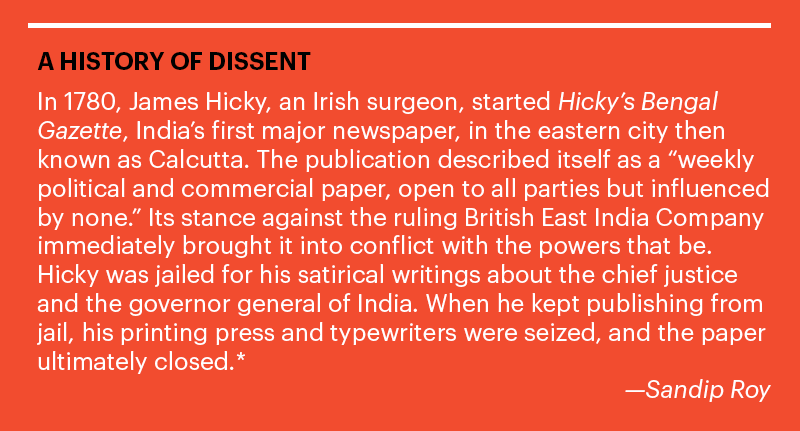
It was a good time to be in the online news business, and our prospects looked limitless. But the fate of our unfettered brand of opinion writing was sealed by two events in May 2014. The first, Prime Minister Narendra Modi’s electoral victory, ushered in a thin-skinned government that quickly established a reputation for punishing its media critics. The second was the takeover of our parent company, Network 18, by Reliance Industries. Reliance is India’s largest private sector corporation, owned by the wealthiest man in the country, Mukesh Ambani, who is known to be an unabashed supporter of the Modi regime.
The full consequences of the new ownership became clear just over a year later, when two Reliance-appointed board members ducked into the Firstpost office to deliver an unambiguous message to its stewards: It’s time to mind your manners. There would be no more “personal criticism” of the ruling party’s leaders on Firstpost. I tendered my resignation 10 days later.
“There is no real freedom of press in India,” a seasoned journalist told me when I first moved back to India from San Francisco in 2008. “There are only windows of opportunity. They open and then they close. You just have to make the most of it.”
The quest for a free press
Media independence has long been a tenuous concept in India. In 1791, American legislators adopted the First Amendment to the US Constitution: “Congress shall make no law … abridging the freedom of speech, or of the press.” But as The Caravan Executive Editor Vinod Jose has noted, India’s “First Amendment [of 1951] said exactly the opposite: nothing in the future shall ‘prevent the State from making any law’ that takes away the freedom of press.” The socialist government expected the Indian press to be loyal partners in the project of nation-building. Some would resist the demand with greater success than others.
In the 1990s, India opened its doors to the global economy, and liberalization swept away the most visible shackles of state control, unleashing a wide array of glossy magazines, colorful broadsheets, and 24/7 news channels. Indian journalism became far more pervasive, lucrative, and noisy, but not much freer. Private ownership brought a different set of restrictions, less visible but no less constraining. “The same loyalty that was rendered to politicians [before liberalization], by the 1990s…[was] transferred to corporate India,” says Jose. The media had simply “found a new master to serve.”
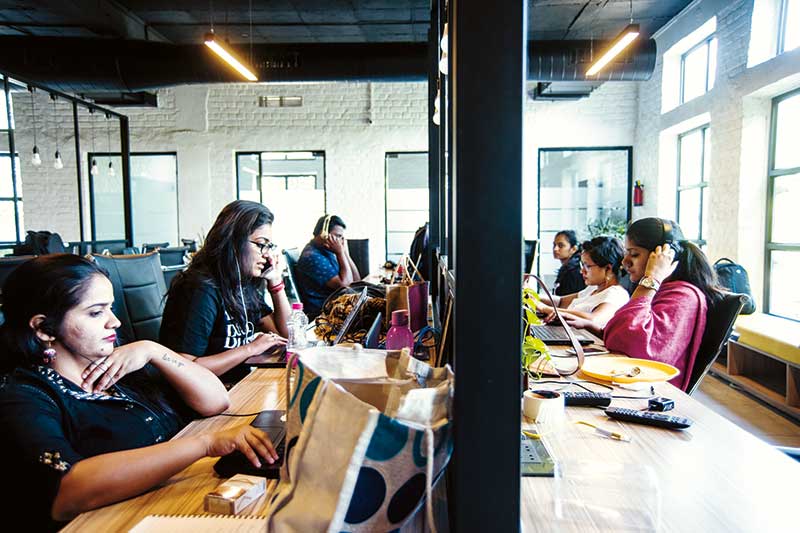
news for millennials By 2021, 64 percent of Indians will be between 20 and 35 years old. ScoopWhoop is determined to become their go-to news source. (Vivek Singh)
India is the world’s largest democracy, but as the media has grown, it has also become more susceptible to political and commercial pressures. Prominent business houses frequently blackball newspapers by withdrawing advertising. Proprietors often call the shots in newsrooms, promoting accommodating editors in service of their other business or political interests. Loosely worded defamation laws allow companies to file multiple lawsuits that drain the resources of errant publications. It’s not all that hard for a powerful politician to oust an editor who steps over the line.
“The government has learned that you don’t have to talk to the editor to control the media. You talk to the [owner]. That guy is vulnerable. He can be subjected to a tax raid, an enforcement raid, some other raid,” says T. N. Ninan, chairman of India’s leading business newspaper, Business Standard. “We have freedom within boundaries. There is no safety if you want to test the boundaries beyond a certain point. The system will come after you in some form or the other, and you have to be ready for that.”
This isn’t to say that the Indian press hasn’t contributed its share of courageous and significant journalism. The free press in India, however, does not exist as a general rule; it relies instead on the fortitude of particular editors or proprietors steering specific publications at certain times in their history. The free market may have transformed the media landscape and the fortunes of its biggest players, but the day-to-day operations of Indian newsrooms have remained as unpredictable as ever.
Against this backdrop, the rise of digital connectivity gains new significance. There are now 684 million unique mobile users in India, of whom more than 370 million access the internet. According to the most recent Internet Trends report, India is the lone star of the global Web, racking up an astonishing 40 percent year-over-year growth rate at a time when the rest of the world is flattening at 7 to 9 percent. The opportunity to attain outsized reach and scale is mind-boggling, but so is the potential to create a truly democratic media powered by ordinary citizens in the most remote stretches of India. It marks the third key moment in the history of Indian journalism, promising to be as transformative as the birth of a post colonial press in 1947 and the rise of corporate media in the late ’90s.
But what shape will this transformation take? Will we witness a US-style disruption, where legacy goliaths will be outdone by a nimble new media? Will digital finally deliver the vibrant independent media that the world’s largest democracy deserves? Or will journalism remain the monopoly of a few corporate giants, whose empires will swallow this new world almost whole, leaving smaller websites to play at the margins? Is this true freedom, at last, or just the illusion of greater choice?
In my search for answers, I talked to powerful media tycoons and fresh-faced entrepreneurs, erudite big-city editors and barely-literate citizen journalists, animated techies who spoke of algorithms, and disenchanted veterans who complained of the tyranny of metrics. Beneath that mountain of words lay older and more universal conundrums about power, access, and money: What is “journalism”? Who does it benefit? And most pressingly, who will pay for it?
A new media for legacy refugees
With his salt-and-pepper beard, public schoolboy accent, Nehru jacket, and professorial glasses, Siddharth Varadarajan is the quintessential Delhi intellectual. He is also the unlikely founder of digital media startup The Wire, an adventure he embarked on after being removed from his job as the editor of The Hindu, the venerable 138-year-old English-language newspaper based in the southern Indian city of Chennai. His ouster was just one of the many high-profile editorial departures attributed to Modi’s rise to power, as a number of legacy outlets scrambled to ensure their top editors would acquiesce as required by the new dispensation. (One of the reasons for Varadarajan’s exit, according to the man who replaced him, was his alleged anti-Modi bias.) When a job offer with a leading magazine group was rescinded for similar reasons, Varadarajan took what he describes as a “leap in the dark,” and helped launch a news and opinion site, TheWire.
Varadarajan is one of a flood of Indian “legacy refugees” who are fleeing the stifling confines of print and TV newsrooms in search of editorial freedom in a brave, new, digital world. They dominate the upper echelons of most of India’s leading independent media websites. The most successful of these, Scroll.in, is helmed by Naresh Fernandes, the former editor of Time Out India. Others include Newslaundry, founded by refugees from print and TV, and India Spend, whose editor ran a newspaper in a past life.
Reputable veteran journalists who could never muster the resources to start a newspaper or a TV channel have found in the digital revolution a cheaper path to independence, made all the more attractive by the promise of exponentially greater reach. “We are tapping into an existing tradition of journalism in this country,” says Fernandes. “Those of us who are dinosaurs, who started off 30 years ago, those are the [journalistic] values we reported with, and those are the values we are reclaiming.”
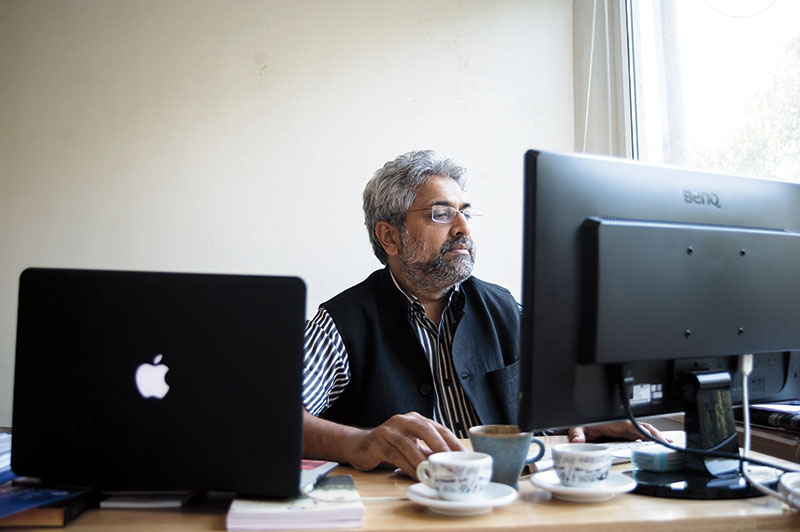
old school Siddharth Varadarajan, founding editor of The Wire, says his site won’t bend to government pressure. (Vivek Singh)
The pattern is somewhat unprecedented. The first Indian newspapers were led by respected print stalwarts. The first private TV channels were founded by Young broadcast Turks. The first generation of independent digital news sites, however, is being steered by legacy journalists, mostly middle-aged and almost invariably male, who are entirely unfamiliar with the new medium they’ve embraced.
The learning curve has been steep, even for a younger founder like 32-year-old Dhanya Rajendran, who launched The News Minute, a south India-focused news site, in 2014, seeking an alternative to the disillusionments of TV journalism. “I had no knowledge of how to start a website. I didn’t even know what a server was,” says Rajendran with self-deprecating humor, acknowledging that “people like us are still stuck somewhere between TV and print. We still haven’t fully figured out what a digital audience wants. We try. Sometimes we do video or data charts, but it is sometimes. We’re not thinking digital all the time.”
The upside of this legacy exodus is that digital media is now home to established journalists who value credibility over clickbait and often produce award-winning journalism. They also remain staunchly critical of a government that is hostile to bad publicity and increasingly able to subdue prominent publications. In August, Outlook, a respected Indian newsweekly, unceremoniously ousted its editor for publishing a cover story alleging that the Rashtriya Swayamsevak Sangh, a right-wing Hindu organization that is the cultural arm of the ruling Bharatiya Janata Party party, was trafficking tribal children to raise them as “good Hindus.” Independent websites offer a haven from this toxic pattern of self-censorship, says Varadarajan. “That, I can say with some degree of [assurance], will not happen at The Wire.”
Digital, however, also breeds discomfort, the kind familiar to legacy journalists across the globe. Scroll editor Fernandes has banned the word “content” from his newsroom, saying: “We do not believe in doing content, we believe in doing journalism, and not for consumers but for readers.” The word “readers,” of course, betrays a print mindset, as does Fernandes’s effort to raise the “credibility” of a medium he believes is considered “less than reliable” by appointing an ombudsman. This wariness of the very nature of online media, however, can make it difficult for legacy editors to grapple with its audience-driven imperatives, which are experienced as antithetical to “good journalism.”
This internal conflict became visibly apparent at an August meeting in Mumbai hosted by Omidyar Network. Also in attendance were representatives from the Gates Foundation and the Independent and Public Spirited Media Foundation, a first-of-its-kind Indian foundation largely funded by Indian tech billionaires that supports media startups, and to which I serve as an adviser. The goal was to bring together their digital media grantees to discuss and share experiences, a conversation that soon turned heated, with one founder declaring, “I will not allow the masses to dictate my editorial policies.” One of the younger attendees described the debate in these terms: “The ruling sentiment was that we need to protect journalism from content,” where “content” is shorthand for everything from A/B testing a headline to using data to guide editorial decisions to embracing technology as not just the form, but the very substance of digital journalism.
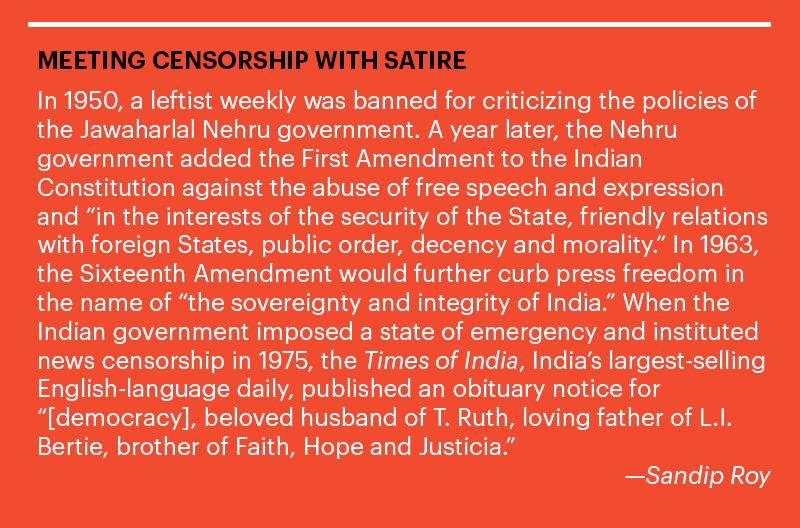
While there has been a flurry of experimentation with videos and podcasts in recent months, it is still a stretch to describe the present crowd of independent news sites as anything close to disruptive. “I think the problem lies with the definition of independent media, which is: ‘We’re doing exactly what is happening in corporate newsrooms, but these are better people doing it,’” says Durga Raghunath, founder of Firstpost and former CEO of Network 18 Digital. “It is not an argument you can buy.” She argues that most standalone news sites are valued for their founders’ reputations, rather than the freshness of their ideas: “I don’t know if there’s anything new here.”
Her view undoubtedly feels ungenerous to its targets. As Wire founder Varadarajan is quick to point out, editorial quality and integrity do indeed have value in themselves, irrespective of the medium. They do not, however, guarantee survival in a constantly shifting online media market.
The present crop of digital news sites in India greatly resembles media ventures of the first-dot com boom in the US. Print veterans David Talbot and Michael Kinsley went on to found hugely successful media companies, but Salon and Slate were created when online media was in its infancy and big media was asleep at the digital wheel. This is a luxury that their Indian peers do not possess. The online universe today is global, staggeringly complex, and offers infinite multiplicity. As consumption moves rapidly from desktop to mobile, big media houses with big budgets flood the digital space with innovative news and entertainment products, and agile new competitors emerge to woo their core audiences, it will become ever more challenging for a Wire or a Scroll to stay put, let alone grow. If India is to have its native-grown equivalents of Politico or Vox—independent news sites that are large and influential enough to alter the media landscape—we’ll need a lot more innovation, agility, and yes, money.
Size matters
When I emailed Vineet Jain, the Managing Director of the goliath-sized Times Group, about the new crop of media startups, his answer was carefully polite to the point of being dismissive: “We always welcome new players because it gives us inspiration to do better. That being said, the challenge for any new player is to develop an offering that can have a scalable impact in India. What we’ve seen thus far is that there’s a lot of new media that caters to smaller sets of audiences, but haven’t broken out further.”
Translation: They’re too small to matter.
That kind of complacency is hardly unexpected in a media company whose digital arm, Times Internet and its 30-plus businesses, reaches an audience of more than 175 million Indians. They are so far ahead of the rest that their only competition is Facebook, with 195 million users in India.
The people I spoke to for this story disagreed on many things, but were unanimous on one count: There will be no US-style print meltdown in India. Legacy outlets here have both more brand recognition and deeper pockets, as paper is still a profitable business. A number of magazines look vulnerable because they haven’t figured out how to stay relevant in a digital news cycle, as do some smaller newspapers. But for the most part, the status quo seems secure.
“The reality of a standalone digital player,” says Anant Goenka, executive director of The Indian Express, a leading English-language newspaper, “is that no matter how ambitious you are, you will hit a ceiling at some point, whether [in] audience size or revenue.”
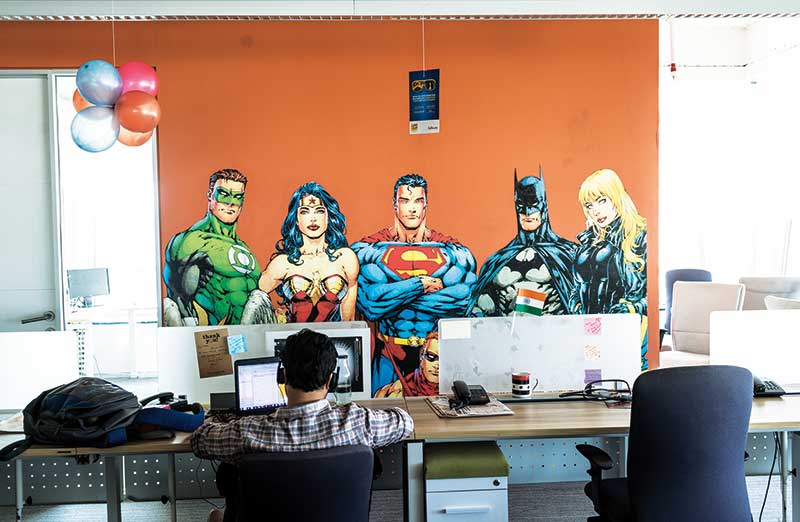
incredible hulk Superheroes adorn a wall at the digital arm of the Times Group, the country’s largest media conglomerate. (Vivek Singh)
India’s legacy media has been quick to learn from the West. The country’s top three news sites are digital extensions of print or TV outlets, and that head start is not just a measure of historical advantage, but of concerted investment. IndianExpress.com, the website of a leading English language newspaper, for example, was lagging behind Firstpost as recently as 2013, but now has pulled far, far ahead with 49 million uniques per month compared to Firstpost’s 18 million, growing its audience seven times over since 2012. The lay of the land isn’t welcoming for new entrants, even wealthier newcomers like Raghav Bahl, the former owner of Network 18, who has since launched his own online media company.
BuzzFeed and Huffington Post in the United States, says Bahl, grew quickly in the period when desktop was the primary mode of online consumption and social media was still new. “BuzzFeed and the others were nimble enough to adapt to an incipient phenomenon called Facebook and Twitter. They got the seven-year shadow where the big guys were not looking at that space,” he says. Independent news sites in India, which appeared around 2012, did not enjoy any such breathing room as the legacy players had already started to pivot toward online expansion, leaving the “newbies” less than two years to build scale.
Bahl plans to overcome these disadvantages through a combination of investment, partnership, and proprietorship. Apart from his own startup, TheQuint.com (a general news site aimed at millennials), and a digital partnership with Bloomberg India, he is also aggressively investing in sites such as The News Minute and Youth Ki Awaaz (Voice of the Youth), a citizen journalism platform mostly for college kids. “Our aim is to aggregate audience scale in our portfolio of assets,” says Bahl, who hopes the cumulative reach of his holdings will propel him into the big leagues.
If impact were measured by reach, most individual news startups would not count for very much. The biggest among them, Scroll.in, claims to attract 3.5 million unique visitors a month. The News Minute (3 million) and The Wire (1 million) are even smaller. The contrast is stark when compared to corporate-owned players or legacy digital sites. (These are self-reported Google Analytics numbers. Independent comScore numbers are abysmally inaccurate in India due to difficulties in sampling and the rapid shift to mobile. They do, however, reflect the same disparity in the relative reach of these sites.)
More strikingly, a number of the startup founders I spoke to are uninterested in closing that gap. “We believe there is a ‘critical readership’ where we will be sustainable to do the kind of journalism we want. Otherwise, you become a giant tent where you shovel everybody in and you have no character and no journalistic mission,” says Fernandes. (According to his business partner that critical number is eight to 10 million.) News Minute’s Rajendran is more blunt. “I don’t want to be mass,” she says. “I want to stay niche.”
Niche outlets can indeed survive by targeting and cultivating a valuable audience for advertisers. But monetization prospects are far less rosy for general news sites that remain just, well, small. “There are only two types of advertiser-driven businesses that are possible in this country. One is a business that is targeted to a particular audience, and is of a particular size so that audience is relevant to an advertiser. The second is of a scale that competes with the likes of Google and Facebook,” MediaNama founder Nikhil Pahwa says. “Everything in the middle is currently struggling.” That’s because roughly 90 percent of all digital ad spends in India go to Google and Facebook, with the remaining share distributed among the biggest players, leaving little more than crumbs for the rest.
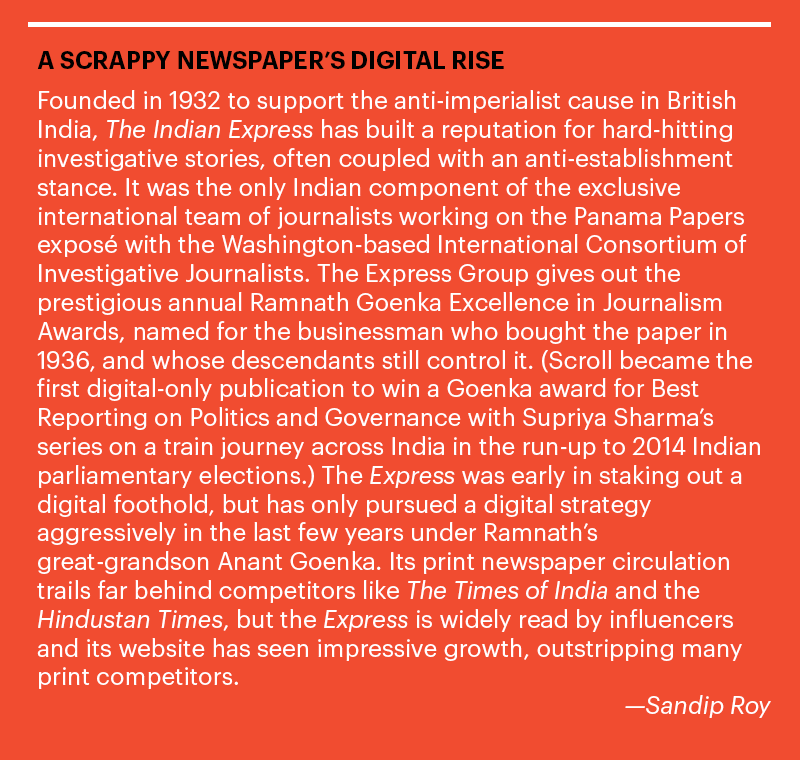
Pressed on their size, editors like The Wire’s Varadarajan and Scroll’s Fernandes often make that old argument—it’s not how many but who we reach—rattling off big names in the upper echelons of the Indian establishment who read or tweet them. Whether that kind of elite play can be reliably monetized in India is an open question. Scroll is gambling on premium native advertising, and The Wire on a non-profit model financed by wealthy donors. There are a lot of ifs and thens along the way, and none of these recipes for survival are assured given the current realities. It may be far easier to start an online publication than print or TV, but it’s also easier to fall by the wayside.
Scale is easy enough to shrug aside in the name of lofty ideals, but it is a critical factor for funders. The digital boom, with its attendant flood in venture capital investment, has raised hopes of a new funding model, but funds that invest in media are few and far between, and their clear preference is for consumer-friendly ventures that can scale fast. Kalaari Capital, a $650 million early-stage fund, has plowed seed money into ScoopWhoop (India’s answer to BuzzFeed);POPxo (a Bustle-style property for young women); and YourStory (a content platform for entrepreneurs). News-driven startups like The Wire and Scroll have been financed instead by social impact funders like Omidyar Network and the Independent and Public-Spirited Media Foundation, also known as the IPS Media Foundation. The amounts those entities give, however, tend to be far smaller; the typical IPS Media Foundation grant to a media startup is $150,000 to 200,000; its biggest grantee, The Wire, received $2.5 million over three years. In comparison, ScoopWhoop raised $4 million in its latest round of funding, and $1.5 million in 2014. Those numbers are dwarfed, in turn, by the news aggregator app Dailyhunt, which boasts more than 120 million downloads and $62 million raised.
Everyone cares about reach, even social impact funders like Omidyar and the IPS Media Foundation. “There can be impact without scale,” writes Omidyar Network Investment partner C.V. Madhukar, but it would be “very local,” which would not in itself be attractive to funders like him. Audience growth and reach are important metrics, he argues, as they show where “there is a genuine need that a product is answering.”
The digital medium has allowed good people to create very good journalism in India, but will it have relevance without a sufficiently large audience, or when dwarfed by the exponential growth of corporate-owned media outlets? Take, for instance, the story of the fired Outlook editor, which was diligently covered by all the independent news sites, but received little or no coverage in larger media outlets. The story died within days, creating barely a ripple. Sometimes, size matters. In India, it may even be required to sweep away the miasma of self-censorship.
When The Washington Post hit an all-time Web traffic high in late 2015, management acknowledged the impact of a vastly revamped mix of content and tools, including a slew of light fare seemingly antithetical to the Post brand. Pressed on the transformation by Digiday, outgoing Post President and General Manager Steve Hills replied, “It’s sort of a false choice: Do you need to be impactful or interesting?… There’s a huge overlap. But first, you have to have a big audience.”
The future of news in India lies with those able to figure out how to build and sustain that audience. These may well be the very same people editors like Fernandes now dismiss as “not our competitors. They don’t do news.”
News of, by, and for millennials
I gingerly step over a sleeping dog into the ScoopWhoop office, and am instantly surrounded by a vast and chaotic group of 20-somethings ensconced in the brightly-colored rooms, corners, and corridors of a sprawling “farmhouse”—a Delhi euphemism for a large bungalow with expansive grounds. With its garish collage-style mural of celebrities including Kim Kardashian and trampoline, foosball table, and picnic tables, the place feels like a cross between a Silicon Valley startup and an Indian college dorm. Someone finally leads me to a conference room, where I meet ScoopWhoop founder and CEO Sattvik Mishra, a bearded, soft-spoken 28-year-old with the relaxed assurance that success confers.
Since ScoopWhoop’s start in January 2014, the site’s audience has grown to astonishing proportions. ScoopWhoop.com, along with its sister sites, Vagabomb and GazabPost, receive 30 million unique views per month; when measured across social platforms like Instagram, Facebook, and Snapchat, their reach totals up to 225 million monthly views. That’s pretty impressive for a moonlighting lark started by a bunch of old college friends to ease the boredom of their desk jobs at an advertising agency. “I was terrified my boss would find out this is what I was doing in my spare time,” recalls Mishra. That was until their stories started going viral, and the same boss encouraged them to quit and set up their own shop.
ScoopWhoop started out unapologetically imitating BuzzFeed with India-themed listicles and other viral content, but has since moved into the broader terrain of news, creating a separate 17-member team helmed by more experienced (read, 30-something) journalists who cover top news stories, though perhaps not with the same tone or authority as The Wire or Scroll.
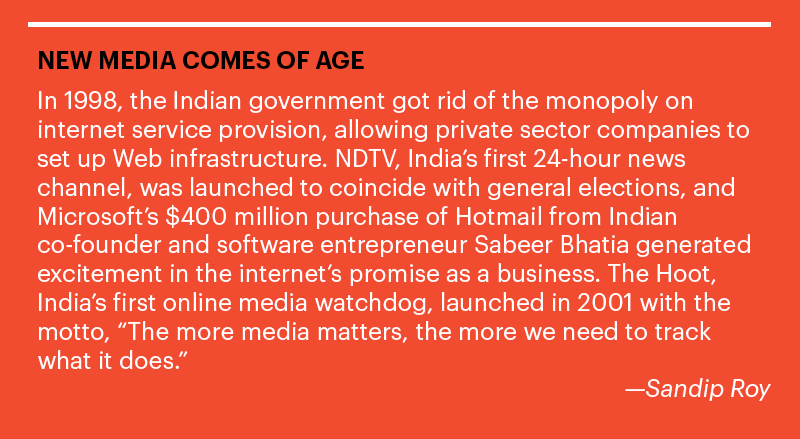
But never mind. This is news for the urban, educated, upwardly mobile 18- to 25-year-old who, as Mishra points out, is loath to be force-fed his greens. “You don’t expect an 18-year-old to open a financial newspaper and read a 5,000-word analysis on the budget.” Young readers instead must be lured into fiscal policy via stories with headlines like “Why the Fuck Should I Care about the Budget,” which speak to pressing concerns such as the price of cigarettes, rum, and Red Bull.
By 2021, 20- to 35-year-olds will account for 64 percent of India’s population, and there is no doubting ScoopWhoop’s determination to define the future of news for what will be the country’s largest generation. That ambition is writ large in the site’s road map, which includes growing its reach beyond urban elites and pushing into smaller cities and towns across India. Most recently, the site has moved aggressively into Vice territory, creating a series of high-quality news documentaries on subjects that once belonged entirely to serious journalism: the uprising in Kashmir, student elections at Delhi University, the underside of the Bollywood movie industry. “The future of ScoopWhoop is this: We want to be the publication of choice for the Indian millennial,” says Mishra. “In the beginning, we were doing mostly entertainment, right? But we soon realized that to build a successful media company, news has to be an important part of the offering. If you want to build credibility, you have to do news.”
Among seasoned Indian journalists, ScoopWhoop occupies the same disdained space as BuzzFeed once did in the United States. It is a handy symbol of all that is trivial about online media, and not without reason. Mishra’s fervor to make “news convenient” and his claims that the definition of news is elastic enough to include a Bollywood star’s PR antics ought to alarm anyone who cares about the future of Indian journalism, irrespective of age. What can be self-defeating about this old-school resistance, however, are the dual impulses to dismiss non-traditional journalists as amateurs and to discount their often-sincere desire to do substantive journalism—just not the way the olds choose to define it.
The past year has witnessed a mushrooming of news products created by millennials and driven by social media, primarily Facebook. A number are mostly infotainment machines, turning news into quick, catchy content intended to go viral. But they also include more earnest enterprises, like What’s The Deal News, founded by two sisters—one a recent Smith College graduate—who are experimenting with pop culture tropes and animated videos as a way to persuade 16- to 24-year-olds to pay attention to the headlines. “These are not people who read the news—at all,” says co-founder Natasha Kewalramani, who has a degree from the School of Oriental and African Studies at the University of London and is hoping to partner with youth-focused channels like MTV to reach her target audience.
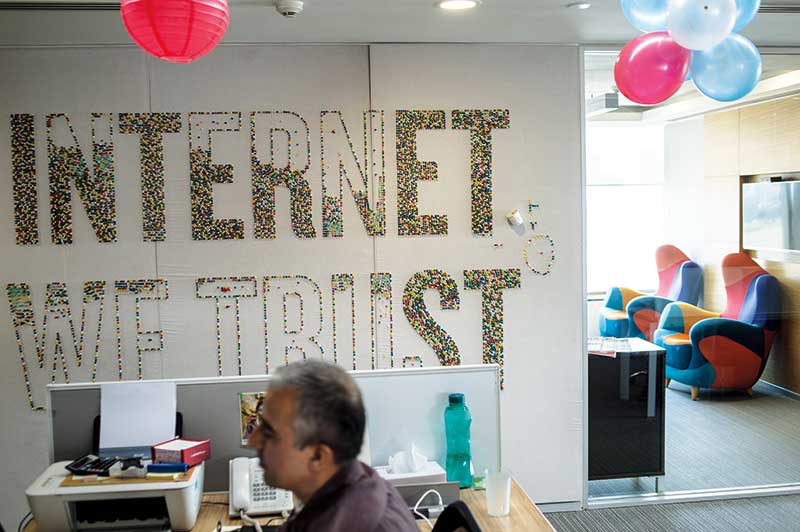
new normal The digital arm of the Times Group describes its office culture as “cool” and full of “perks” like pool tables. “Here, bouts of laughter and crazy songs form the background score for meetings that result in the next killer digital product,” its website boasts. (Vivek Singh)
Others are building more traditional newsrooms in the hope of graduating to more substantive reporting, like The Better India, an Upworthy-esque site that focuses on “positive” stories of activism.Started by a husband-wife team who quit their corporate careers to make a difference, TBI was a response to the negativity and sensationalism of mainstream news. “It got us thinking: What should news do to you? Should it shake you up in horror? Should it leave you disgusted? Or should it also make you learn? Should it make you contribute? Should it enable you to bring about a change?” the founders, Dhimant Parekh and Anuradha Kedia wrote in a newspaper op-ed. What started out as a straightforward curation of upbeat stories has evolved into a news operation with loftier ambitions.
“Our first step was to sensitize our audience to a wide variety of [social change] issues,” Parekh tells me. “Now that we’ve got them here, our next step is to hold their hand and guide them to go deeper into some of these areas, be it sanitation or healthcare. If you stay shallow, you can’t have impact.” The small independent website has built a monthly audience of 2.5 million (not counting its Facebook audience of 40 million per month) whose loyalty and engagement would be the envy of any news organization. Its recent video on the creator of edible cutlery went viral in March, and then global, with The Guardian and others picking up the story.
Yet mention The Better India to traditional reporters and editors, and you’ll often get a bored shrug, mostly because its founders are business school graduates who don’t qualify, in their minds, as “real journalists,” and its stories, however well-reported, don’t fit the J-school definition of news. This blinkered definition of what and who has credibility is no longer relevant to an online audience that primarily discovers its news via social media, and is increasingly indifferent to the brands and bylines attached. As The Boston Globe’s outgoing digital managing editor, David Skok, prophetically noted in 2012: “[T]he aggregators of today will be the original reporters of tomorrow. Those of us who care about good journalism shouldn’t dismiss the BuzzFeeds of the world because they aren’t creating high-quality reporting. Their search for new audiences will push them into original content production.”
Websites like ScoopWhoop and TBI are following the very same path from building an audience to offering substantive reporting. While they are unlikely to seriously threaten a Times of India or Indian Express, Skok offers an instructive warning to other startups about the future of journalism, which will be shaped by this new generation of news producers and consumers.
The original promise
In a bare little room in Raipur, the capital of Chhattisgarh, one of India’s poorest states, I sit on the floor with the attendees of a media training workshop conducted by CGNet Swara, citizen radio for India’s poorest indigenous people. The dozen, barely literate villagers have traveled great distances to learn to become reporters, or “bolkars” (literally, skilled speakers), for CGNet’s internet radio program. In their polyester pants and neatly-tucked shirts, conspicuously grimy around the collars, they offer a stark contrast to the jeans-clad hipsters that crowd Delhi newsrooms. Everyone in the room owns a mobile phone,half of which are smartphones, but none can explain what the internet is.
“Do you know how the fishing net is? How the ropes criss-cross one another?” asks CGNet Swara founder Shubhranshu Choudhary. “Now imagine there are wires, invisible wires, that connect computers in that same way, so they can speak to one another.”
Having explained the nature of the internet, he makes the trickier leap of connecting digital media to democracy. “When we speak to each other in this room, the only medium we require is air. Who owns the air? Nobody. So we can speak freely,” he begins. “Then humans made machines so we can communicate at vast distances, through newspapers, radio, television. But those machines require money, and belong to those who paid for them. Now we have the medium of digital, which is not free like air, but close to it. Because now that computer sits in your phone, and we can once again speak to each other, tell our stories, in our language.”
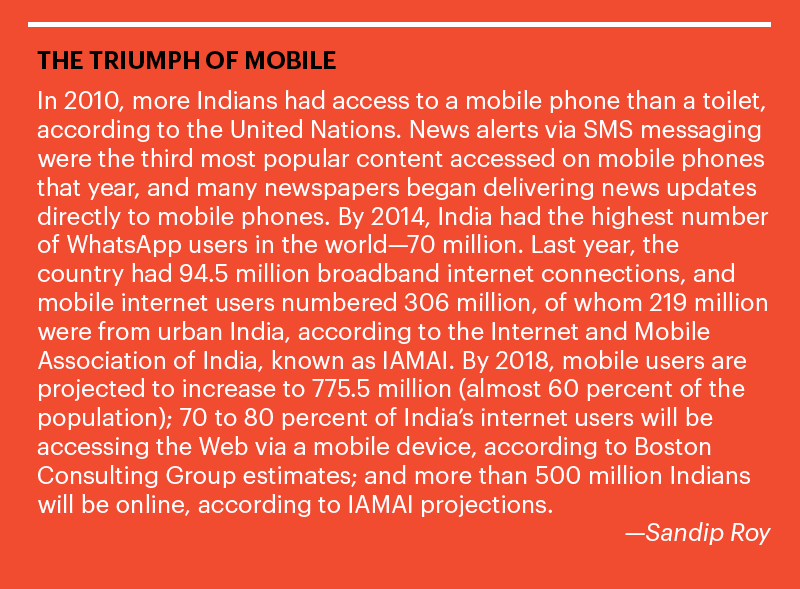
CGNet deploys a simple network that combines mobile phones, computers, and bluetooth technology to create local journalism of the most old-fashioned kind. The bolkar dials a server and hangs up so the server can call him right back, letting him record his “report” at zero cost. These are often accountability stories, or their beginnings—public schools that were never built, policemen who harass villagers—accompanied by the names and phone numbers of local government officials. These then are fact-checked, edited, and pushed out online to urban, even global audiences. When I ask 32-year-old Jeetanram, who only uses one name, about his recent report on two women and their babies who’d died in childbirth, his face lights up. “They died because there is no road, you see, so we could not take them to the hospital,” he explains. The story, posted on Facebook, caught the attention of an Indian professional working in New York who called the local district official named in Jeetanram’s report to express his displeasure. Dismayed by this unexpected level of public scrutiny, the local government swung into hurried action. “Now we have a road, even some hand pumps [for water],” Jeetanram says. “I feel I have done so much good for my people.”
These stories of poor health care and missing public schools are of no interest to the average Indian newspaper or TV reporter; people like Jeetanram do not figure in his reporting except as casualties in the ongoing conflict between the government and the Maoist extremists, which is the only story in Chhattisgarh that reliably makes the national news. This is media of, by, and for poor indigenous people living in a state controlled by mining companies, militias, and the military. It is the consequence of India’s much-vaunted mobile phone revolution.
In September, Reliance launched India’s largest 4G mobile phone network, pledging the cheapest data and voice plans carried over networks that will penetrate the remotest parts of the country.* Reliance chairman Ambani declared the dawn of a new age in which the digital life of “no Indian is ever threatened by scarcity, poor quality or unaffordability of data,” and where “access to information knows no barriers.” Of course, this plan for national domination could well deliver the opposite: complete control over what anyone on the network reads or sees. But in the context of grassroots projects like CGNet Swara, it also offers hope.
In that small room, far from the chatter about scale and monetization, I encountered echoes of a long-forgotten promise made back in 2006 when Time magazine anointed “You” as its person of the year, celebrating the rise of Web 2.0: “It’s about the many wresting power from the few and helping one another for nothing and how that will not only change the world, but also change the way the world changes.” For the privileged few, that exultant sense of the future has been replaced by anxieties about Facebook privacy and Twitter trolls. However, for the poorest rural Indians, the cellphone has brought new hope, if not of great change, at least of being heard.
“Digital has performed a public service in India. It’s made people fundamentally more accountable, whether it is the press, whether it is the politicians, whether it is business. I think people have found a voice,” says Raghunath, the Firstpost co-founder. “I don’t know if there are single players who are going to change the game, but taken collectively, it has been very, very powerful.”
There is hope that a chorus including everything from award-winning reporting by Scroll or The Wire to inspirational stories on The Better India, from a ScoopWhoop documentary to an Indian Express op-ed or a story filed by a farmer on his phone, can create a more democratic media and a more democratic nation.
The question that remains is the one Choudhary asks his audience in Raipur: “Iska daam kaun dega?” (Who will pay its price?) For now, no one has a good answer.
*An earlier version of this story incorrectly identified the company that launched India’s largest 4G mobile phone network.
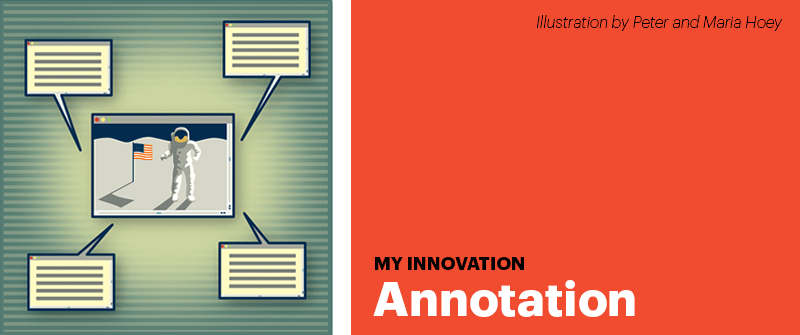
The private and intimate act of engagement with the written word, which once took the form of underlined sentences and scribbles in margins, has found new, more public life in digital journalism with the advent of annotation software. The Washington Post has redeployed Genius, a tool created for music fans, as an instrument of political commentary. Where excerpts of original source material were once included as quotes in a story, context and comments are now embedded within the very object of analysis. Deepstream, a new tool in beta from the MIT Media Lab, allows users to layer information onto video feeds, which in turn helps newsrooms instantly contextualize live footage; think pop-up video meets Facebook Live. A perennial indicator of reader interest, annotation is coming of age as a significant re-visioning of our core roles in framing, explaining, and analyzing the news. What once was marginalia is now journalism.
*An earlier version of the sidebar titled “A History of Dissent” incorrectly identified the first newspaper owned and managed by Indians.
Lakshmi Chaudhry is an adviser to the Independent and Public-Spirited Media Foundation, where she guides investments in social impact media startups. Previously, she was the co-founder and executive editor of Firstpost.com, a news and opinion website that was one of India’s earliest digital-first outlets. Her writing has appeared in a variety of publications, including The Nation, Al Jazeera, Wired, the Village Voice, and The New Republic.

